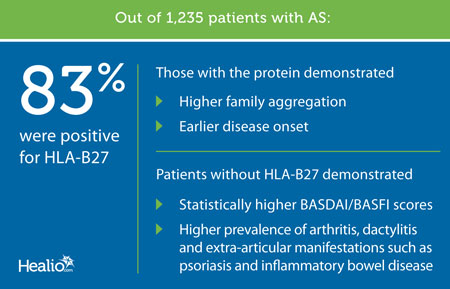HLA-B27 Linked to Earlier Disease Onset in White Patients With AS
Among white patients with ankylosing spondylitis, presence of the human leukocyte antigen B27 protein is linked to an earlier disease onset and higher family aggregation, according to findings published in Arthritis Research & Therapy.
However, the researchers also found that the absence of the protein is related to a higher frequency of peripheral arthritis, dactylitis and extra-articular manifestations. In addition, its presence is not linked to a higher disease burden or anytime uveitis.
“Previous studies suggest a relationship between HLA-B27 and axial manifestations including structural progression in early [axial spondyloarthritis],” Marta Arévalo, of the Autonomous University of Barcelona, and colleagues wrote. “Moreover, a younger age of onset, more family history, and less prevalence of psoriasis and [inflammatory bowel disease] have also been reported. Nevertheless, there are few studies evaluating the role of HLA-B27 in defined AS patients, with some of them focused on radiographic progression and reporting controversial results.”
To evaluate the influence of HLA-B27 on the clinical phenotype of individuals with AS, the researchers conducted an observational, cross-sectional, descriptive study using data from 1,235 patients in the Spanish REGISPONSER registry. The database includes patients who fulfilled the European Spondyloarthropathy Study Group criteria for spondyloarthritis.

Arévalo and colleagues reviewed and compared the patients’ demographic and clinical information, as well as disease activity based on the Bath Ankylosing Spondylitis Disease Activity Index (BASDAI), Bath Ankylosing Spondylitis Functional Index (BASFI), erythrocyte sedimentation rate (ESR) and C-reactive protein (CRP). They also analyzed the patients’ radiographic data, including Bath Ankylosing Spondylitis Radiology Index (BASRI) scores. The researchers completed univariate and multivariate analyses to identify variables independently related to HLA-B27’s presence.
According to the researchers, 83% of the 1,235 included patients were positive for HLA-B27. Those with the protein demonstrated higher family aggregation and earlier disease onset, compared with those without the protein. In addition, patients without HLA-B27 demonstrated statistically higher BASDAI and BASFI scores, as well as a higher prevalence of arthritis, dactylitis and extra-articular manifestations such as psoriasis and inflammatory bowel disease, but not uveitis, compared with those with the protein.
“This is the most extensive study analyzing differences in Caucasian AS patients regarding their HLA-B27 status,” Arévalo and colleagues wrote. “This study confirms the previously reported association in AS patients between HLA-B27 and an earlier disease onset and greater family aggregation. However, and interestingly, we do not support an association between HLA-B27 and the extent of axial structural damage, or a higher clinical burden of the disease.”
The researchers also noted that “we cannot prove an association between the presence of anytime uveitis and HLA-B27 in definite AS patients. On the other hand, the absence of HLA-B27 is related, in AS patients, to a higher frequency of peripheral arthritis, dactylitis, and extra-articular manifestations.” – by Jason Laday
Disclosure: Arévalo reports no relevant financial disclosures. Please see the study for all other authors’ relevant financial disclosures.
